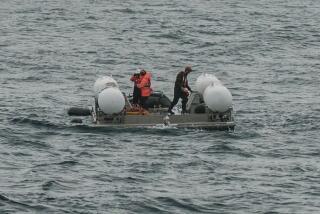Robots Play Key Roles in Flight 990 Salvage Efforts
- Share via
NEWPORT, R.I. — Deep Drone is a sports car among robot submarines--light and agile, but not really suitable when the going gets rough.
Magnum is a robot submarine truck--heavier, stronger and built to take a beating.
The two robots are being used by the Navy to search the ocean bottom for the “black box” recorders from EgyptAir Flight 990. National Transportation Safety Board investigators hope the recorders will provide key evidence as to why the Boeing 767 crashed into the sea on Oct. 31, killing all 217 on board.
Rough weather let up Friday morning, permitting the Navy to anchor a recovery ship, the Grapple, over the spot about 60 miles south of Nantucket where the jumbo jet hit the water.
Sonar listening equipment on the Grapple picked up audible “pings” broadcast by locater transmitters on the recorders, giving technicians a rough idea of where to search.
Deep Drone, a tethered robot about the size of a Mazda Miata, swam 260 feet down to the ocean floor to have a look. Sunlight doesn’t reach that far, and visibility in the dark, murky water was limited to about 6 feet.
Using its own sonar, headlamps and television cameras, Deep Drone searched in vain. Technicians think the cockpit voice recorder and flight data recorder are buried beneath mud and debris, and despite clawing away at the sandy ocean bottom with its robotic claws, the submarine failed to unearth either recorder.
The weather worsened early Saturday, forcing a halt to Deep Drone’s efforts. But by the afternoon, a break in the weather allowed work to resume. Rising seas after nightfall, however, tore loose one of the Grapple’s mooring anchors and the Navy had to take another break.
When the weather failed to improve Sunday morning, officials decided it was time for Magnum, a robot about the size of the beefed-up, four-wheel-drive vans used in the Australian outback.
“It will enable us to continue the recovery effort in more difficult conditions,” NTSB chairman Jim Hall said.
By noon, the Navy had welded Magnum’s crane and control booth to the deck of the Carolyn Chouest, a support ship equipped with multiple propulsion thrusters that enable it to maintain a precise fixed position in heavy seas without the use of anchors.
Unlike Deep Drone, Magnum is surrounded with a steel cage that will protect it in case it bangs against the ship’s hull while being launched in heavy seas. Officials said the robot should be ready to resume the search before dawn today.
Deep Drone has to be pulled from the water when waves get about 8 feet tall and threaten the Grapple. But Magnum, with the Carolyn Chouest providing a more stable platform, can handle seas twice that size, the Navy said.
Like Deep Drone, Magnum has sonar, headlights and television cameras. Its two four-fingered claws swivel at the ends of two powerful arms.
By daybreak, the Navy said, Magnum should be at work, digging up objects from the ocean bottom and examining them with its video eyes. By nightfall, seas are expected to calm, and Deep Drone should be able to join its bigger brother.
Officials say that once the recorders are found, they will be flown to Washington for examination.
Thus far, the cause of the crash has remained a mystery. Several theories have been proposed, but they are largely conjecture.
The NTSB says the recorders, if they are recovered in reasonably good shape, could change all that.
The cockpit voice recorder retains the last 30 minutes of sounds in the cockpit, including pilot conversations, radio transmissions, the noise of the engines and the sounds of switches being thrown and controls being moved.
The flight data recorder on the EgyptAir 767 logs at least 55 technical aspects of the flight, including altitudes, airspeeds, engine performance, instrument readings and the positions of flight controls.
More to Read
Sign up for Essential California
The most important California stories and recommendations in your inbox every morning.
You may occasionally receive promotional content from the Los Angeles Times.













